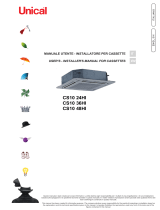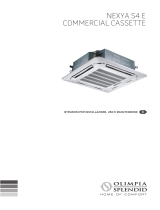
© 2022 Carrier. All rights reserved.
A Carrier company
Edition Date: 09/22 Catalog No: IM-38MURA-02
Replaces: IM-38MURA-01
38MURA: Installation Instructions
Manufacturer reserves the right to change, at any time, specifications and designs without notice and without obligations.
18
START-UP
Test Operation
Perform a test operation after completing a gas leak and electrical safety
check. Review the indoor unit installation instructions and owner's
manual for additional start up information.
System Checks
1. Conceal the tubing where possible.
2. Ensure that the drain tube slopes downward along its entire length.
3. Ensure all required piping and connections are properly insulated.
4. Fasten the tubes to the outside wall, when possible.
5. Seal the hole through which the cables and tubing pass.
Outdoor Unit
1. Are there unusual noises or vibrations during operation?
Explain the Following Items to the Customer (with the
aid of the Owner's Manual):
2. Explain care and maintenance.
3. Present the installation instructions to the customer.
CARE AND MAINTENANCE
To help ensure high performance and minimize possible equipment
failure, periodic maintenance must be performed on this equipment.
Maintenance frequency may vary depending upon geographic areas.
TROUBLESHOOTING
For ease of service, the systems are equipped with diagnostic code
display LEDs on both the indoor and outdoor units. The outdoor
diagnostic display are two LEDs (Red and Green) on the outdoor unit
board and is limited to very few errors. The indoor diagnostic display is a
combination of flashing LEDs on the display panel or the front of the
unit.
There may be a few error codes displayed in the indoor unit that might
relate to the outdoor unit’s problems. If possible, always check the
diagnostic codes displayed on the indoor unit first.
OUTDOOR UNIT DIAGNOSTIC GUIDES
For ease of service, systems are equipped with diagnostic code display LEDs on the indoor and outdoor units. Outdoor diagnostic is displayed on the
outdoor unit microprocessor board. There may be a few error codes displayed in the indoor unit that might relate to the outdoor unit's problems. If
possible, always check diagnostic codes displayed on the indoor unit first. The diagnostic codes displayed on the outdoor units are listed on Table 10.
Table 10 — Outdoor Unit Diagnostic Codes
NOTE: It is a normal to display DF or FC, not a malfunction.
For additional diagnostic information, refer to the service manual.
DISPLAY ERROR INFORMATION DISPLAY ERROR INFORMATION
EC5C High pressure sensor failure PC0F PFC module protection
EC57 Refrigerant pipe temperature sensor error PC0L Low temperature protection of outdoor unit
EL01 Communication malfunction between indoor and outdoor
units PC10 Outdoor unit low AC voltage protection
EC50 Outdoor temperature sensor error PC11 Outdoor unit main control board DC bus high voltage pro-
tection
EC51 Outdoor EEPROM error PC12 Outdoor unit main control board DC bus high voltage pro-
tection /341 MCE error
EC52 Condenser coil temperature sensor (T3) malfunction PC30 System high pressure protection
EC53 Outdoor ambient temperature sensor (T4 ) malfunction PC31 System low pressure protection
EC54 Compressor discharge temperature sensor TP has an
open or short circuit PC40 Communication error between outdoor main chip and com-
pressor driven chip
EC07 Outdoor DC fan motor malfunction/fan speed out of con-
trol PC42 Compressor start failure of outdoor unit
EC71 Over current failure of outdoor DC fan motor PC43 Outdoor compressor lack phase protection
EC72 Lack phase failure of outdoor DC fan motor PC44 Outdoor unit zero speed protection
EL16 Communication malfunction between outdoor unit main
board and outdoor transit board PC45 Outdoor unit IR chip drive failure
PC00 Inverter module (IPM) protection PC46 Compressor speed has been out of control
PC02 Top temperature protection of compressor PC49 Compressor overcurrent failure
PC06 Discharge temperature protection of compressor PH90 High temperature protection of Evaporator
PC08 Outdoor overcurrent protection PH91 Low temperature protection of Evaporator
PC0A High temperature protection of condenser LC06 High temperature protection of Inverter module (IPM)




















